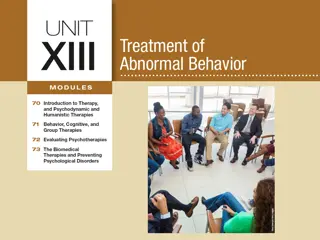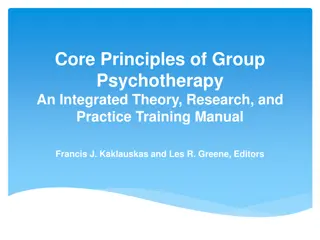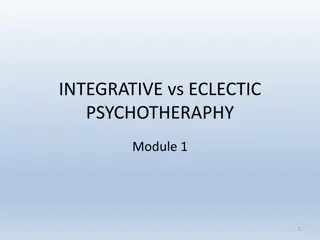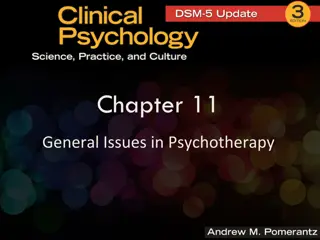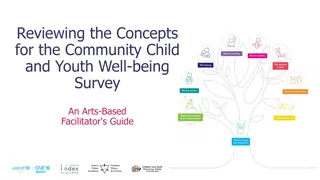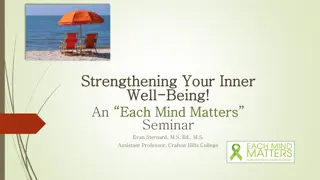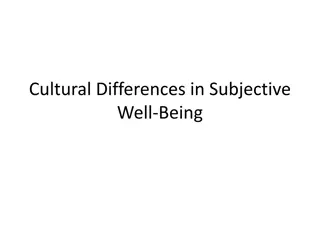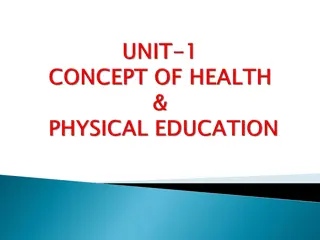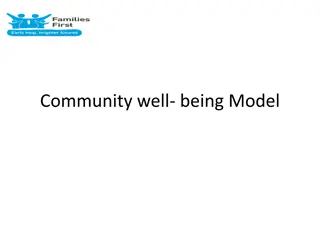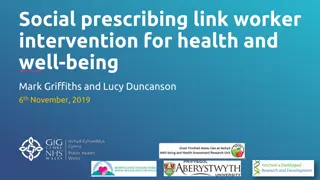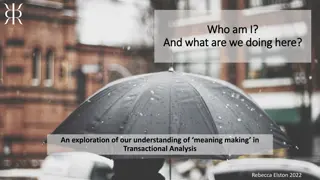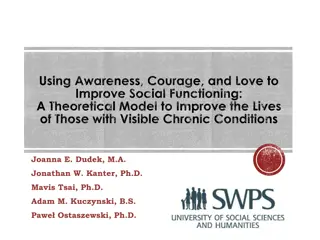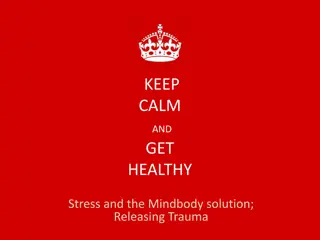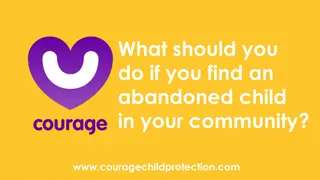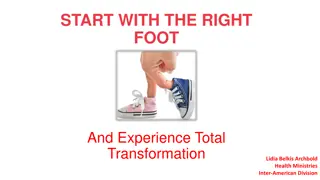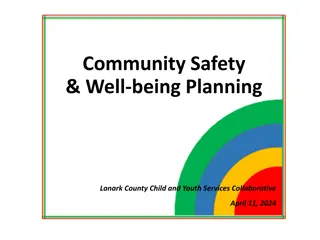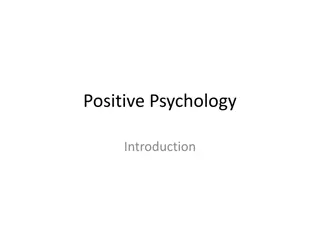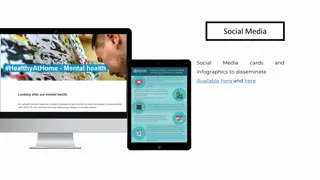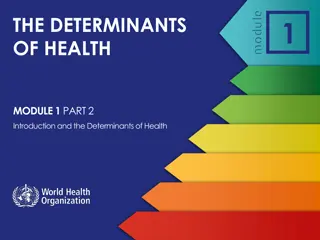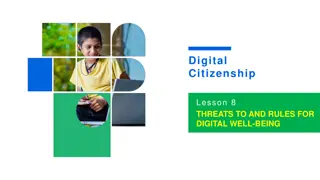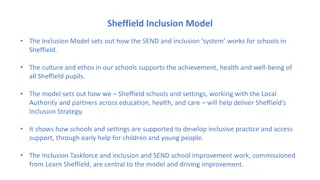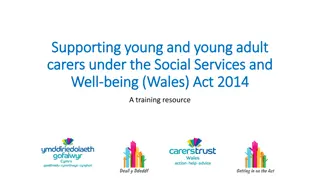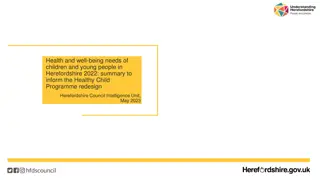Discovering the Right Psychotherapy for Your Well-Being
Psychotherapy offers a way to manage troubling thoughts, feelings, and behaviors to enhance well-being. Explore client and therapist characteristics, available therapeutic approaches like CBT and ERP, and considerations when choosing the right therapy for you.
Download Presentation

Please find below an Image/Link to download the presentation.
The content on the website is provided AS IS for your information and personal use only. It may not be sold, licensed, or shared on other websites without obtaining consent from the author. Download presentation by click this link. If you encounter any issues during the download, it is possible that the publisher has removed the file from their server.
E N D
Presentation Transcript
Discovering a psychotherapy that fits for you . . . 23,24 REFLECT 1. Client characteristics Do I enjoy structured activities or open-ended dialogue? Am I ready to explore my thoughts, feelings, and behaviours in new ways? Am I ready to learn new skills? What s available in my area? What type of therapy has been recommended to me in the past? What is psychotherapy? 23,24 MORE INFO Psychotherapy is a way to help people manage troubling thoughts, feelings, or behaviours so they can increase their well-being. 2. Therapist characteristics and expertise Does the therapist seem open, accepting, and genuine? Do they see my strengths and worldview? Do they invite me to step outside of my comfort zone and practice new skills? Do they share an understanding of my concern? It might also be called counselling or therapy. 3. Research evidence Is there research support showing this approach may reduce my concern?
Interpersonal Therapy Mindfulness-Based Therapy Acceptance and Commitment Therapy (ACT) Cognitive Behaviour Therapy (CBT) MORE INFO Psychotherapeutic Approaches Exposure with Response Prevention (ERP) Dialectical Behaviour Therapy (DBT) Transdiagnostic Approach / Universal Protocol (UP) Trauma-Informed Eye Movement Desensitization and Reprocessing (EMDR) CBT
In CBT you might learn to overcome fears by gradually facing the things you are afraid of. This helps you learn that things you fear aren t always as dangerous as you might think In CBT you might learn to stand back from your thinking to consider situations from another view point ILLUSTRATIVE CONCEPT ILLUSTRATIVE SKILL Two people stand in line at a rollercoaster. One looks really excited and the other looks scared. Some people might think the situation is making them feel a certain way, but it s the same rollercoaster how could they feel so different? Perhaps one person is thinking about how fun the rollercoaster will be and the other is thinking something bad may happen. This means their feelings are less influenced by the situation and more by what they are saying silently to themselves (thinking). Tim is afraid to talk to classmates. This can be broken down into a number of small steps that slowly get harder. Tim can practice step one until he feels less afraid, and then he can move to the next step. 1. Say, Hi to a classmate in the hall 2. Ask a quick question, Is there a math quiz on Friday? 3. Share his weekend plans with a classmate In CBT, you will practice catching what you say to yourself and change it to help you feel (more brave, less angry, less sad, more relaxed etc.). Adjusting what you tell yourself can help you feel and act differently.
In ERP you might learn to gradually face things you are afraid of while stopping yourself from engaging in an urge or action once your anxiety is triggered ILLUSTRATIVE SKILL Sally has constant thoughts about whether the oven was turned off, even after checking once. This causes her uncomfortable feelings of worry, so she repeatedly checks to see if the oven is off. She sometimes goes to great lengths to do so, such as travelling home from work or social events to check. Sally might practice leaving her home briefly (exposure), and not returning home to check the oven (response prevention).
In mindfulness you might learn to connect with the present moment by pausing and TAKING 5-4-3-2-1 ILLUSTRATIVE SKILL In mindfulness you might learn there are thoughts and there is you observing them 5 things you can see. ILLUSTRATIVE CONCEPT Thoughts are like: 4 things you can feel. Waves rising from the ocean to touch the shore and then head back out to sea. You can watch the waves without being swept away. 3 things you can hear. 2 things you can smell. Trains coming and going while you stand and watch from the platform. 1 thing you can taste. Junk mail. You can t stop it from coming, but you don t have to read it! In mindfulness you might learn to breath in through your nose, noticing the gentle rise of your belly, and out through your mouth. ILLUSTRATIVE SKILL
In DBT, you might learn to name and change feelings by taking the opposite action In DBT, you might learn to improve relationships and communicate more effectively with others ILLUSTRATIVE SKILL ILLUSTRATIVE SKILL If you feel sad and want to withdraw from people, phone a friend G Be gentle. Don t attack, threaten, or judge others I Show interestand listen (don t interrupt others to speak) V Validate the other persons thoughts and feelings E Try for an easy attitude (smile and be light-hearted) If you feel tired and want to stay in bed, take a shower and walk around the block If you feel afraid of an event and want to stay away, go instead. When overwhelmed, make a list of small steps and DO the first thing on the list In ACT, you might learn to notice and tolerate unpleasant emotions ILLUSTRATIVE SKILL OBSEREVE: Scan your body from head to toe and bring awareness to your feelings BREATH: Take a few deep breaths EXPAND: Make room for the feelings ALLOW: Allow the feelings to be there SAY: Thisfeeling is unpleasant, but I can accept it
In IPT you might explore an exchange between yourself and a significant other ILLUSTRATIVE CONCEPT You might explain the setting, words, tone, and non-verbal cues as well as the emotions you experienced like a movie script. You might explore what you meant to communicate and what may have actually been communicated. Next, you might role play (practice) with your therapist a different or new way of communicating in the future. In TF-CBT, you might share your adverse experience with your therapist through talking, writing, or art, after you ve established a safe and comfortable relationship, and practiced other coping skills ILLUSTRATIVE CONCEPT
If this is an emergency, CALL 9-1-1 immediately. Or go to a local emergency department. GET HELP Book an appointment with your family doctor or nurse practitioner. They can evaluate your situation, talk to you about treatment options, and refer you to a community mental health service provider. Call or web search for a provincial mental health access line. Provincial health authorities usually offer a non-urgent mental health referral service. Mental health access lines can discuss your needs and direct your referral as needed. Talk to your school or education team (if appropriate). Provincial school authorities/boards/districts and post-secondary institutions often have on-site mental health services or they may be knowledgeable about other local mental health services. Talk to your employment insurance provider or professional associations. Employment insurance programs and local professional associations (e.g., provincial psychology or social work association) may offer lists of private practitioners offering mental health care in your area.
Next steps in discovering a psychotherapy that fits for you . . . REFLECT Do I have a specific concern that I want to address? Am I interested in improving my overall wellness? Am I interested in exploring my thoughts, feelings, and behaviours in new ways? What is psychotherapy? 23,24 Am I interested in learning new skills? MORE INFO Psychotherapy is a way to help people manage troubling thoughts, feelings, or behaviours so they can increase their well-being. Which approach resonated most with me? Which approach am I most interested in trying? What s available in my area? PERHAPS I AM READY TO TALK TO A MENTAL HEALTH SERVICE PROVIDER TO LEARN MORE.



